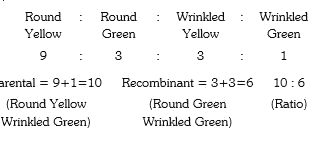In a typical Mendelian cross, which is a dihybrid cross, one parent is homoxygous for both dominant traits and another parent is homozygous for both recessive traits. In the F2 -generation, both parental combination and recombinantions appear. The phenotypic ratio of parental combinations to recombinations is
10:6
12:4
9:7
15:1
The correct Answer is:A
In a dihybrid cross the phenotypes are in the ratio is

Similar Questions
In Mendalian dihybrid cross what is the ratio of offsprings heterozygous for both the traits and offsprings heterozygous for single trait respectively?
View SolutionIn a typical mendellian cross which is a dihybrid cross, one parent is homozygous for both recessive traits. In the F2 generation, both parental combinations and recombination appear. The phenotypic ratio of parental combination appear. The phenotypic ratio of parental combinations to recombinations is
View Solution
Knowledge Check
- Question 1 - Select One
In a typical Mendelian cross, which is a dihybrid cross, one parent is homozygous for both dominant traits and another parent is homozygous for both recessive traits. In the F2 -generation, both parental combination and recombination appear. The phenotypic ratio of parental combinations to recombination is
A0.42083333333333B0.50277777777778C0.37986111111111D0.62569444444444 - Question 2 - Select One
In a typical Mendelian cross which is a dihybrid cross, one parent is homozygous for both dominant traits and another parent is homozygous for both recessive traits. In the F2 generation, both parental combinations and recombinations appear. The phenotypic ratio of parental combinations to recombinations is
A10:6B12:4C9:7D15:1 - Question 3 - Select One
In a typical Mendelian cross, which is a dihybrid cross, one parent is homoxygous for both dominant traits and another parent is homozygous for both recessive traits. In the F2 -generation, both parental combination and recombinantions appear. The phenotypic ratio of parental combinations to recombinations is
A15:1B12:4C9:7D10:6
Generation of non-parental gene combinations in F2 generation is due to
View SolutionF2 generation of a dihybrid cross possesses one or both the dominant traits in proportion of
View SolutionThe case in which F1 generation resembles both parents is known as
View SolutionWhat is the probability of homozygous plants for both dominant characters in F2 generation of a dihybrid cross :-
View SolutionA cross involving parents differing only in one trait is
View Solution
